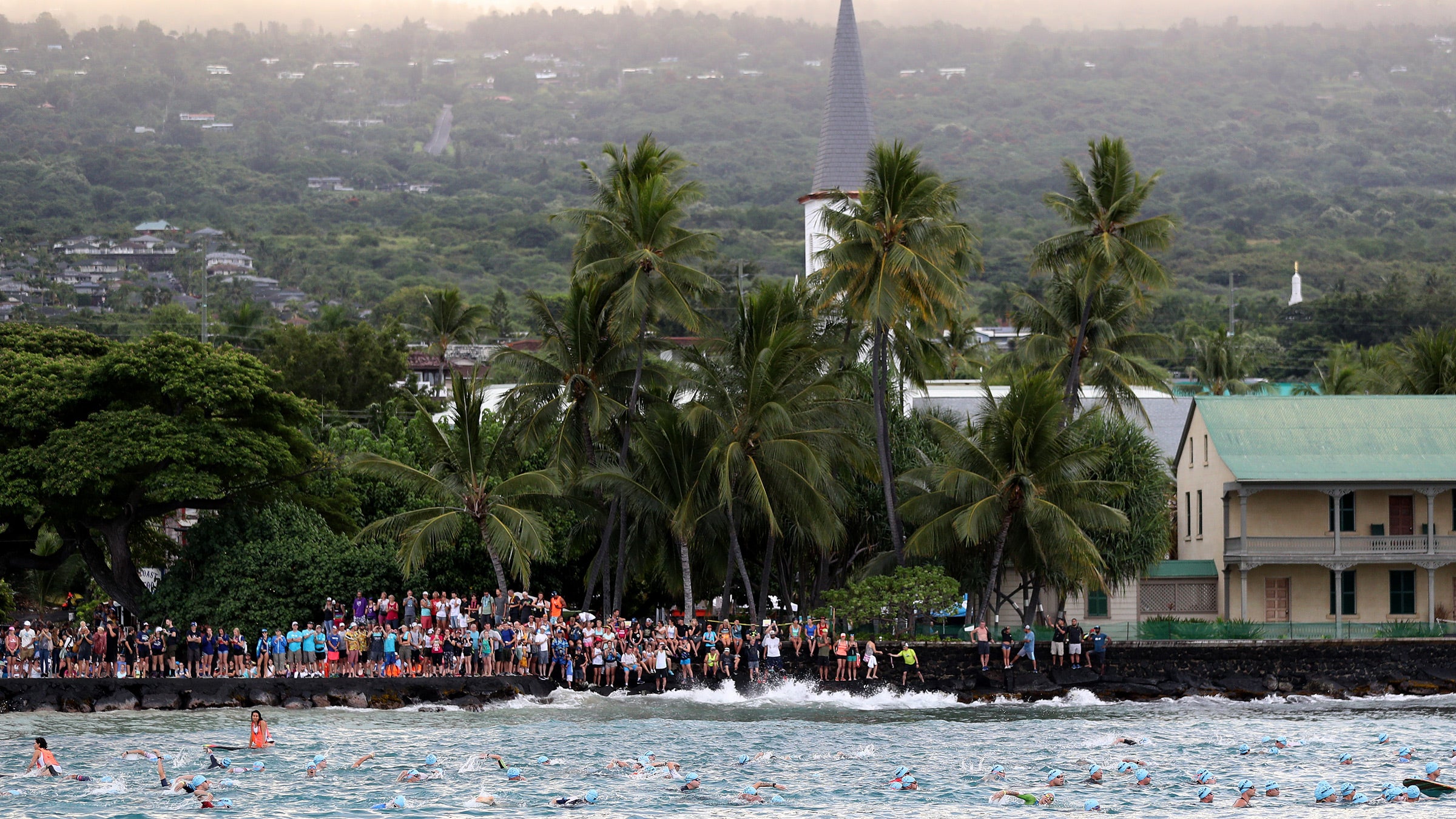How Kona Is Coping Without Ironman

Athletes swim in the 2019 Ironman World Championship while a crowd looks on. (Photo: Maxx Wolfson/Getty Images for Ironman)
More than 1.7 million people visited the Big Island of Hawaii in 2018. A little more than 20,000 of those came for the Ironman World Championships. While Ironman athletes, supporters, and spectators make up a small portion of visitors each year, the Big Island—and Kailua-Kona in particular—have never been more desperate for triathletes to return for racing, training, and all the spending money that comes with that.
Hawaii currently has an unemployment rate of 22.6 percent, which is the second highest in the country behind only Nevada. Mayor Harry Kim of Hawai’i County, which encompasses the entire Big Island, estimates the number is even higher in Kailua-Kona, where hotels and resorts are the primary employers.
It’s a catch-22 that the one place in the country that’s been least affected by COVID-19 from a healthcare perspective has been one of the most affected economically. Hawai’i Island (the proper name for the Big Island) has recorded just 85 cases of the virus without a single death. Only one patient has been hospitalized overnight since the start of the pandemic. It helps that Hawaii is the most isolated island chain on earth and closing its borders isn’t very hard. It also helps that residents took it seriously from the get-go, wearing face masks and practicing social distancing, which isn’t difficult in the Aloha State. For many locals who bemoan the constant influx of tourists, the past few months have had an upside.
“The longtime residents say this is what old Kona felt like,” said David Wild, a teacher and triathlete who relocated to Kailua-Kona six years ago. “There’s always this little buzz of tourism around town. I think a lot of residents feel a little sigh of relief without that constant buzz, but with that relief comes the realization that some of these businesses won’t make it through this.”
Now comes the scary part for Hawaii residents and officials. Tourism makes up 21 percent of Hawaii’s GDP, so they can’t keep outsiders away much longer. As the state slowly begins to reopen and welcome travelers—and eventually triathletes—back to its islands, with that comes the threat of a COVID outbreak. Governor David Ige issued a mandatory 14-day quarantine for all visitors to Hawaii on March 26, and that’s currently set to stay in place until at least July 31.
Whether or not that 14-day quarantine will be lifted before the Ironman World Championship rescheduled for Feb. 6 of next year remains one of the biggest questions for athletes planning on racing. There’s no better way to blow a taper than to be holed up in a hotel room for the two weeks leading up to race day. It also puts a damper on the steady stream of training camps and athletes in the months before race day. But the bigger question is if the postponed Kona race will even be able to happen in February.
“Right now it’s June and all we can do it hope that the race is able to take place in February. The reality might be something different come December, but all we can do for now is hope that the world will be in a place in February that we’re able to welcome Ironman back,” said Mayor Kim. He’s, likewise, hopeful the quarantine orders won’t be necessary by February, but there’s no way to know right now.
“Unfortunately, we can only control our state and our island. We can’t control what happens between now and then in the places where people will be coming from. The success of the event in February will depend on the rest of the world,” said Kim.
For now, the town triathletes know so well is looking to slowly jumpstart an economy that has been decimated. A couple of businesses along the famed Ali’i Drive have already shuttered for good, including Bongo Ben’s Island Café, one of the most popular restaurants for athletes during Ironman week. There will likely be more empty storefronts along Ali’i whenever Ironman ultimately returns. But there will also be an island more eager than ever to be taken over by spandex-clad weirdos from around the world.
“Ironman reflects the apex of what the human body is capable of,” said Kim. “To me it signifies what human beings are capable of in terms of physical health and conditioning. What better way to symbolize to the world that we have this pandemic under control than to have an Ironman here with people from all over the world? That’s what it will represent to me. It’s not just about bringing it back for economic purposes.”